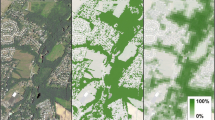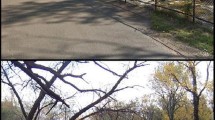Abstract
Two datasets of percent urban tree canopy cover were compared. The first dataset was based on a 1991 AVHRR forest density map. The second was the US Geological Survey’s National Land Cover Database (NLCD) 2001 sub-pixel tree canopy. A comparison of these two tree canopy layers was conducted in 36 census designated places of western New York State. Reference data generated by photo-interpreting the tree cover on 1994 and 2002 orthoimages were compared on a city-wide basis to estimates of the tree cover derived from the AVHRR and NLCD tree canopy maps. Comparison of the AVHRR-based estimate with the 1994 photo-interpreted reference showed low accuracy and high variability. The comparison between the NLCD-derived estimate and 2002 photo-interpreted values had higher accuracy but shows a consistent under prediction bias for all tree cover values. In comparing the two photo-interpreted reference sets, little actual change was detected for this study region. Assessing change using differences between the imagery-based AVHRR and NLCD urban tree cover datasets is shown to lead to erroneous results.






Similar content being viewed by others
References
Dwyer JF, Nowak DJ, Noble MH, Sisinni SM (2000) Connecting people with ecosystems in the 21st century: an assessment of our nation’s urban forests. Gen Tech Rep PNW-GTR-490. Portland, OR: U.S. Department of Agriculture, Forest Service, Pacific Northwest Research Station. 483 p. URL: http://treesearch.fs.fed.us/pubs/12517 (last accessed: 11 May 2007)
Homer C, Huang C, Yang L, Wylie B, Coan M (2004) Development of a 2001 National Land Cover Database for the United States. Photogramm Eng Remote Sensing 70(7):829–840 URL: http://www.mrlc.gov/pdfs/July_PERS.pdf (last accessed: 11 May 2007)
Homer C, Dewitz J, Fry J, Coan M, Hossain N, Larson C, Herold N, McKerrow A, VanDriel JN, Wickham J (2007) Completion of the 2001 National Land Cover Database for the Coterminous United States. Photogramm Eng Remote Sensing 73(4):337–341 URL: http://www.mrlc.gov/pdfs/April_07_highlight.pdf (last accessed: 11 May 2007)
Huang C, Yang L, Wylie B, Homer C (2001) A strategy for estimating tree canopy density using Landsat 7 ETM+ and high-resolution images over large areas. Third International Conference on Geospatial Information in Agriculture and Forestry. Denver, CO. CD-ROM. URL: http://landcover.usgs.gov/pdf/canopy_density.pdf (last accessed 11 May 2007).
Ji L, Gallo K (2006) An agreement coefficient for image comparison. Photogramm Eng Remote Sensing 72(7):823–833
Mendenhall W (1979) Introduction to probability and statistics, 5th edn. Wadsworth, Belmont, California
Nowak DJ (1994) Understanding the structure of urban forests. J For 92(10):42–46 URL: http://www.fs.fed.us/ne/syracuse/Pubs/Downloads/94_DN_UnderstandingStr.pdf (last accessed: 11 May 2007)
Nowak DJ, Hoehn RE, Crane DE, Stevens JC, Walton JT (2007) Assessing urban forest effects and values, Philadelphia’s urban forest. Resource Bulletin NRS-7. U.S. Department of Agriculture, Forest Service, Northern Research Station, Newtown Square, PA, p 22URL: http://nrs.fs.fed.us/pubs/9659 (last accessed: 11 May 2007)
R Development Core Team (2007) R: a language and environment for statistical computing. R Foundation for Statistical Computing, Vienna, Austria ISBN 3-900051-07-0, URL: http://www.R-project.org
Walpole RE, Myers RH (1985) Probability and statistics for engineers and scientists, 3rd edn. MacMillan, New York
Walton JT (2005) An investigation of national tree canopy assessments applied to urban forestry. Ph.D. Dissertation. State University of New York, College of Environmental Science and Forestry. Syracuse, NY. 95 p. UMI Publication Number: AAT 3200353
Willmott CJ (1984) On the evaluation of model performance in physical geography. In: Gaile GL, Willmott CJ (eds) Spatial statistics and models. D. Reidel Publishing Company, pp 443–460
Yang L, Huang C, Homer CG, Wylie BK, Coan MJ (2003) An approach for mapping large-area impervious surfaces: synergistic use of Landsat 7 ETM+ and high spatial resolution imagery. Can J Remote Sensing 29(2):230–240 URL: http://www.mrlc.gov/includes/pdfs/CJRSimpmapping2003.pdf (last accessed: 11 May 2007)
Zhu Z (1994) Forest density mapping in the lower 48 states: a regression procedure. Research Paper SO-280. U.S. Department of Agriculture, Forest Service, Southern Research Station, New Orleans, LA, p 11URL: http://www.srs.fs.usda.gov/pubs/rp/rp_so280.pdf (last accessed: 11 May 2007)
Acknowledgments
The work of Jayme Rapp, who did the photo interpretation, and Brett Kelly, who has helped develop the NLCD tree canopy layer for zone 63, both students at the State University of New York—College of Environmental Science and Forestry (SUNY-ESF), is gratefully acknowledged. David J. Nowak (USDA Forest Service) and Stephen V. Stehman (SUNY-ESF) reviewed an early version of the manuscript and provided many helpful suggestions. This work was done in cooperation with USGS EROS Data Center and many other cooperators. Funding for this project was provided, in part, by the USDA Forest Service’s RPA Assessment Staff and State & Private Forestry’s Urban and Community Forestry Program. Data analysis for this project was done in part using the open source statistical software R (R Development Core Team 2007). The use of trade, firm, or corporation names in this article is for the information and convenience of the reader. Such use does not constitute an official endorsement or approval by the United States Department of Agriculture or Forest Service of any product or service to the exclusion of others that may be suitable.
Author information
Authors and Affiliations
Corresponding author
Rights and permissions
About this article
Cite this article
Walton, J.T. Difficulties with estimating city-wide urban forest cover change from national, remotely-sensed tree canopy maps. Urban Ecosyst 11, 81–90 (2008). https://doi.org/10.1007/s11252-007-0040-9
Received:
Accepted:
Published:
Issue Date:
DOI: https://doi.org/10.1007/s11252-007-0040-9




